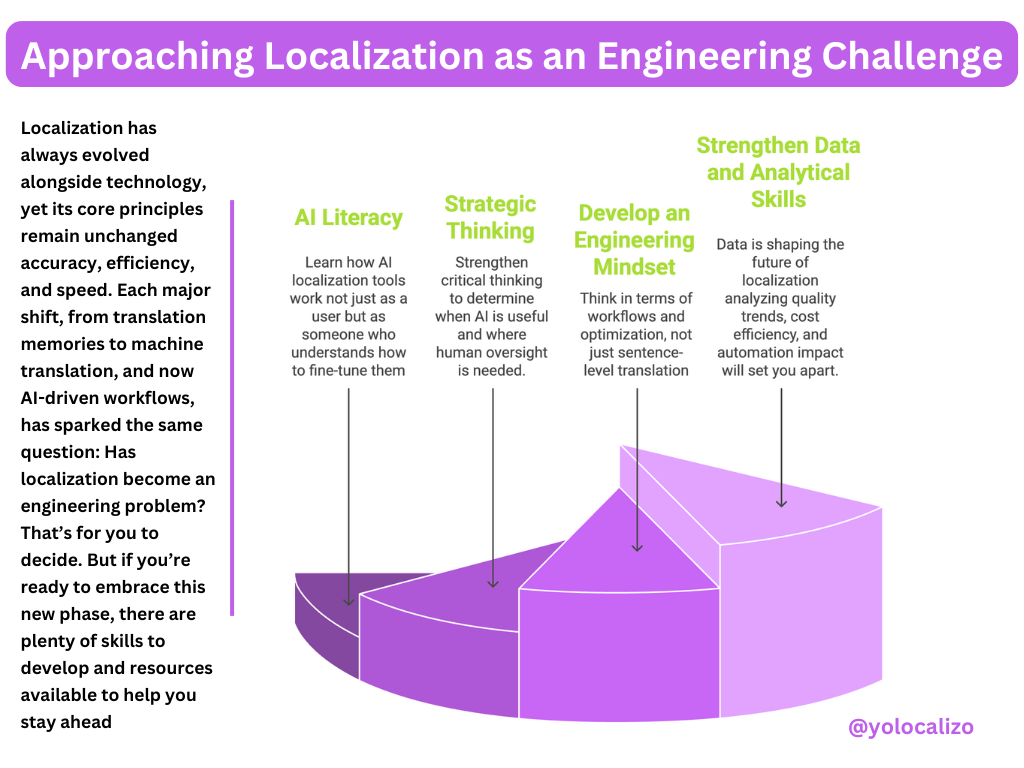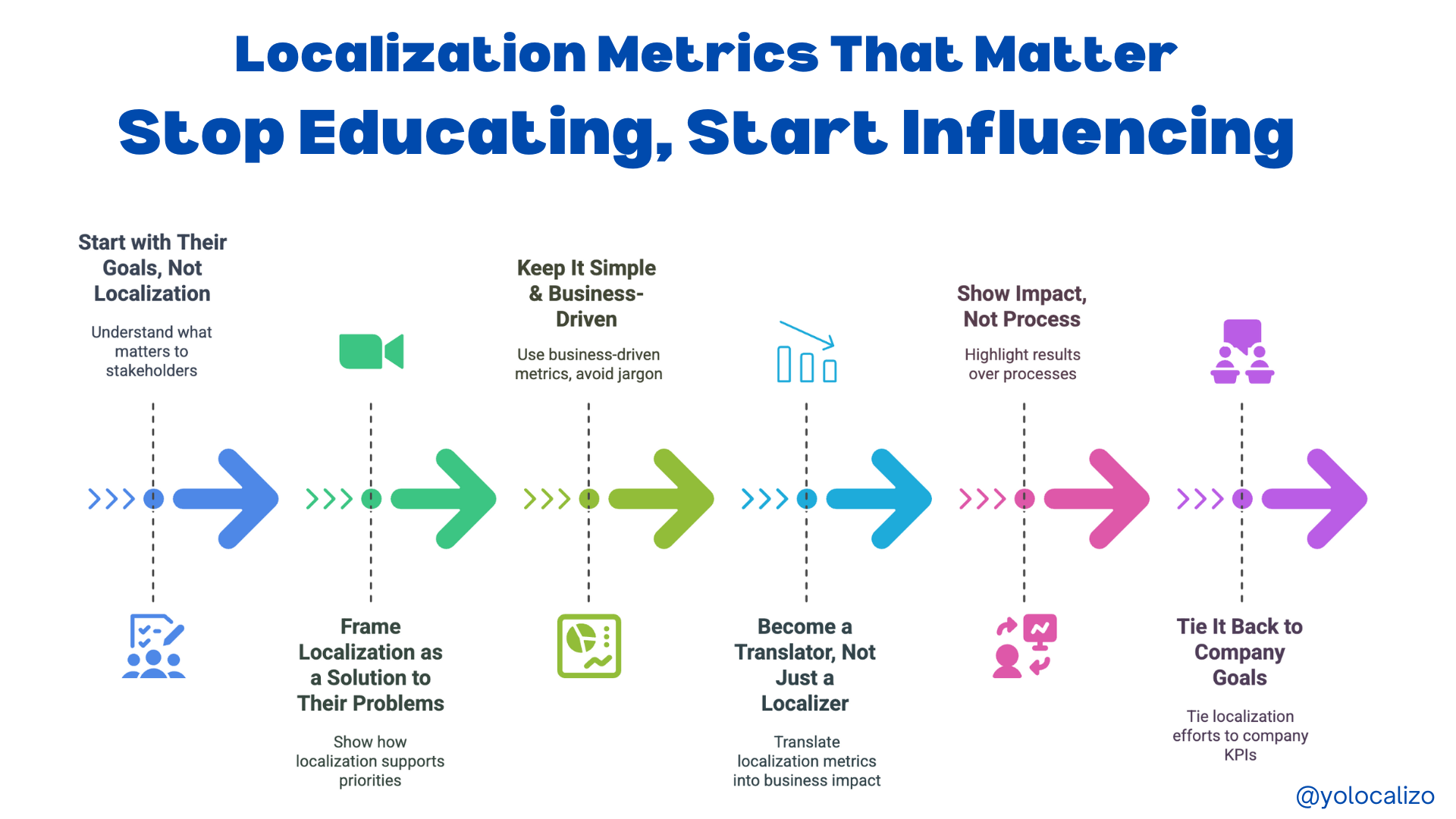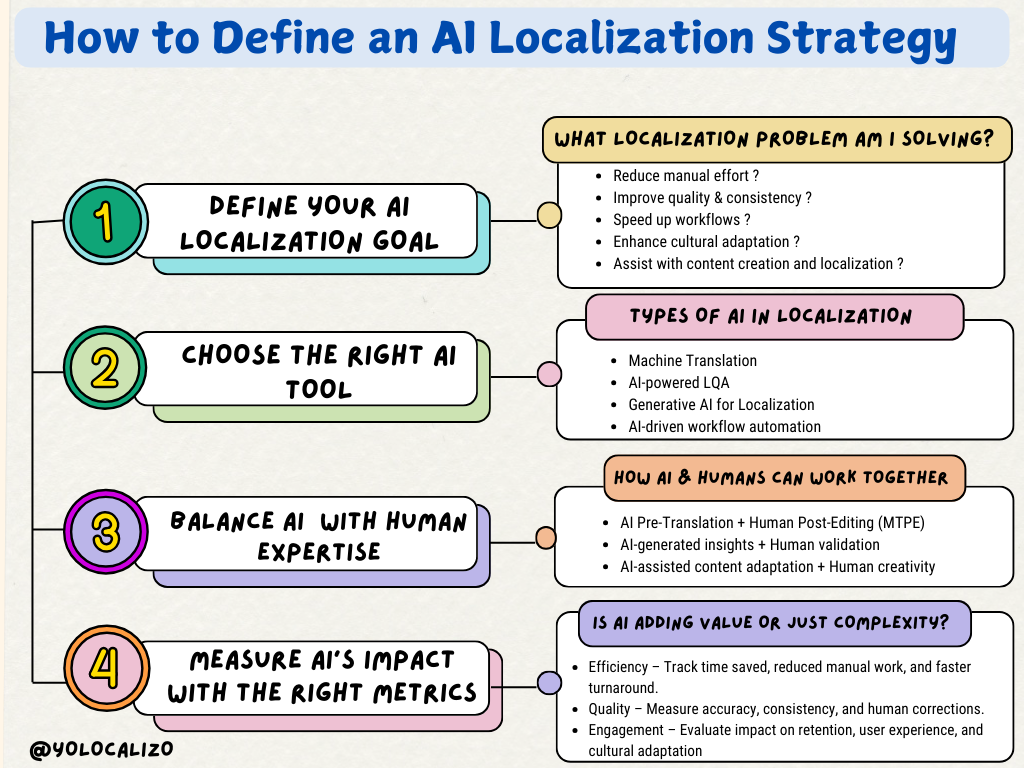Speak the Language of Decision-Makers
I’ve been in many meetings where I walked out thinking I got too caught up in the details, again. I’d start explaining a localization process, how we ensure quality, and how we manage linguistic assets, and before I knew it, I had lost the room. Senior leaders weren’t rejecting localization; they just saw it as one piece of a much larger puzzle. Hopefully, little by little, I learned to handle those situations better.
I’ve had this conversation with many colleagues, and the pattern is always the same: we’re so passionate about what we do that we jump straight into explaining processes and frameworks. But product owners and business leaders aren’t looking for a deep dive into localization mechanics they want to understand how it impacts their customers and revenue..
Most business leaders don’t think much about localization; they care about their customers and product revenue. If we want localization to be seen as important, we need to stop focusing on localization jargon when talking to the C-suite and start talking about business results and outcomes.
Sure, quality is important, but that’s a conversation with our localization peers and LSPs. When talking about quality with business leaders, the approach needs to be different, so the real impact of localization is considered.
3 Ideas How Reframe Localization for Business Leaders
Click HERE to download the infographic
1.- From Translation Accuracy → To Business Risk
As localization professionals, we often get caught up in industry jargon, using terms that don’t resonate with decision-makers. Discussions about translation quality, best practices, and style may be engaging for those of us in the field, but they don’t always add value for those focused on the bigger picture. For them, localization is just one part of a larger strategy, not the entire puzzle. If we want to make localization a priority, we need to frame it in a way that aligns with business goals and outcomes, not just linguistic details.
So a possible scenario for reframing ….
Instead of: “We need better quality control in translations.”
Say: “Poor translations can create legal risks, mislead customers, and damage brand reputation.”
Business leaders constantly evaluate risks, whether financial, legal, or reputational. They don’t see localization as a standalone function; they see it in terms of potential risks and rewards.
If a translation error misleads customers, it can result in lost trust and lost sales. If a product description or legal disclaimer is poorly translated, it can create compliance issues or even legal liabilities in certain markets. If an advertisement accidentally offends a culture, it can lead to brand damage and negative PR.
By framing localization as a risk management tool, we align with how executives think.
It’s no longer about debating linguistic accuracy; it’s about ensuring the company avoids costly mistakes, protects its reputation, and maintains customer trust worldwide. That’s the kind of conversation business leaders are willing to have.
2.- From Language Tone → To Customer Trust
As localization professionals, we know how meaningful, natural, and fluent translations are. However, for decision-makers, the priority isn’t linguistic perfection; it’s how well the content connects with customers. A translation that feels too literal or stiff may not seem like a big deal to an executive, but what they do care about is customer trust, engagement, and sales. If content feels unnatural, it creates friction, making customers question whether the brand truly understands them.
So, a possible scenario for reframing …
Instead of: “The tone of this translation doesn’t match our brand voice..”
Say: “When content feels native, customers are more likely to trust the brand and make a purchase.”
Trust is one of the most powerful drivers of customer behavior. People buy from brands they understand, relate to, and feel confident in. If a company’s messaging feels unnatural, inconsistent, or poorly localized, it raises red flags for customers, making them hesitant to engage, subscribe, or make a purchase.
When decision-makers see localization as a trust-building tool, their perspective shifts. It’s no longer just about translating words; it’s about making customers feel like a brand truly speaks to them. A seamless, well-localized experience signals professionalism and care, reinforcing the idea that the company values its global customers just as much as its domestic ones.
By framing localization as an investment in customer confidence, we make it clear that it’s not just about language; it’s about removing friction, increasing engagement, and, ultimately, driving sales. When customers feel understood, they stay loyal, and loyalty leads to long-term revenue growth.
3.- From a Cost View to a Value View
When discussing localization with decision-makers, cost is often the first concern that comes up. If the conversation is framed around translation being expensive, leadership may see it as an area to cut costs rather than invest. Instead of focusing on price alone, we must shift the discussion to value, how localization contributes to business growth, customer engagement, and brand expansion.
Not all content needs the same level of localization effort. High-impact, customer-facing content benefits from human expertise, while AI-assisted translation can efficiently handle large-scale, lower-risk content. A strategic mix allows companies to maximize reach without overspending.
Instead of: “Human translation is too expensive, so let’s use AI.”
Say: “Using a mix of AI and human expertise ensures cost-efficient translations while maintaining high engagement.”
Executives aren’t interested in the mechanics of localization they care about efficiency and return on investment. Localization won't be a priority if they see it as an expensive, slow-moving process with unclear benefits. But if they see it as a strategic investment that balances cost and impact, they’ll be much more likely to support it.
Business leaders constantly evaluate where to allocate budgets for the highest return. They don’t want to overpay for a process that could be streamlined, but they also don’t want to cut corners if it means losing customers or damaging their brand. That’s why the conversation shouldn’t be about humans vs. machines but about using the right mix of tools and expertise to maximize efficiency.
By framing localization as a smart, cost-effective business strategy, we shift the conversation from cost to value. Instead of debating whether machine translation is “better” than humans, we focus on which approach delivers the best results for the lowest investment. This makes localization a scalable, revenue-driving function rather than an operational expense leaders feel pressured to cut.
In conclusion
Localization professionals bring immense value to businesses, but too often, that value is perceived not in the content itself but in how we communicate it. If we want localization to be prioritized, funded, and integrated into business strategy, we must reframe the conversation from technicalities to business impact.
Instead of focusing on translation accuracy, talk about business risk and brand protection. Instead of debating linguistic style, highlight how localization builds customer trust and increases conversions. And instead of positioning localization as a cost, demonstrate how it drives value and efficiency when approached strategically.
@yolocalizo










What if inclusive localization isn’t just the right thing to do but also the smartest way to break free from outdated pricing models? In this post, I explore the core elements of an inclusive localization strategy and why it might be the key to escaping the trap of price-per-word thinking.